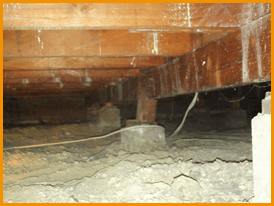Pier and Beam Foundations
Pier and beam foundations have many pros and cons. They can become damaged. Most of the structures you see that have pier and beam foundations were constructed in the late 50’s, although a lot were still built in the early 1960’s. They are sometimes referred to as “post and beam” foundations. Even today, many fine new houses are constructed using piers and beams even though they have many advantages and disadvantages and are prone to deterioration.

What Is A Pier And Beam Foundation?
A pier and beam foundation is type of substructure that is elevated, with a crawlspace that is typically 18” high directly underneath it. Utilities such as plumbing and electrical units are installed in the crawlspace. Unlike a slab foundation, a pier and beam substructure does not rest directly on the ground and unlike most homes in the the north, it does not have a basement.
The interior of a pier and beam house (the floors) rests on floor joists, which rest of beams that are typically made of wood. These can experience deterioration. The beams are positioned and on top of piers that are drilled into the ground in order to make the structure stable. The exterior of the house is supported by concrete beams or a masonry frame.
Pros Of Pier And Beam Foundations:
- Because of the crawlspace underneath them, it is very easy for workers to get under the house in order to fix any problems related to plumbing and electrical matters. Accessing plumbing in slab foundations requires cracking the concrete slab and that can be costly and messy.
- The floors in these structures are pleasing to walk on because they are not resting on a hard, concrete surface.
- Some foundation repairs are easier to make on these substructures
Cons Of Pier And Beam Foundations:
- If not properly vented, mold and mildew can form in the crawlspace, damage and wooden members and develop an unpleasant musty smell. Because of the wood, termites can become a problem.
- Rodents and insects can nest in the crawlspace. You may want to review information of what causes foundation damage on pier and beam houses.
- If there is no insulation under the structure, floors can become very cold when the temperatures drop. Pipes beneath the house can freeze, too.
- Sagging and creaking is common in the flooring of pier and beam structures.
- An excessive amount of rain can also accumulate under their structures if they lack proper drainage. That would require foundation drainage correction due to issues.
- They require that you walk upstairs in order to enter them. This can pose a problem for individuals with disabilities.
To find out more, study the six common problems with pier and beam foundations. It’s important to take steps to preserve your house.
